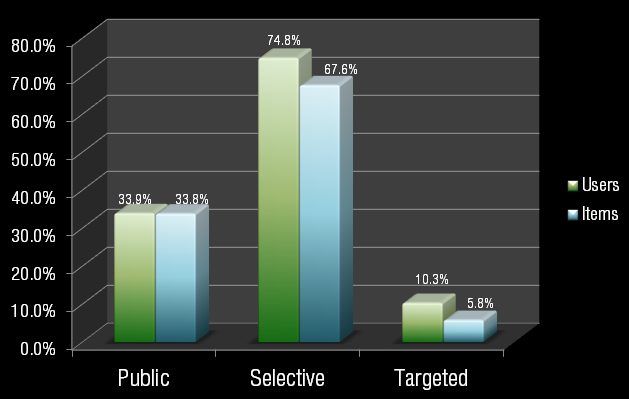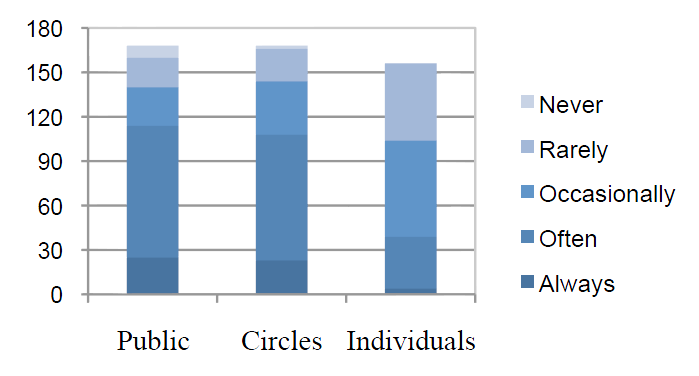Review of the first empirical study of Google+ platform in the context of selective sharing.
Real-World Sharing & Social Networks
Sharing information is a crucial part of human interaction and communication, however in the offline world we manage the information we disclose in a natural and effortless way. We decide what and when to share with different facets of our social circles.
Social networks however have for a long time practiced the ‘all or nothing’ principle where shared information may reach wider audience than users may prefer. One paradox tied to social networks is the phenomenon of ‘over-sharing’, even by users who are aware of its potentially negative consequences.
Academic Research
In a paper called “Talking in Circles: Selective Sharing in Google+” [1] , a team of researchers from Stanford University and Google examine the process of selective sharing within Google’s new social media platform.
Research activities outlined in the paper included an elaborate field trial and analysis of sharing patterns extracted from a large-scale dataset. Some of the observed behaviours include sharing with public, direct users and limited Circles.
The initial study looks at ways ‘pro users’ (or early adopters) interact and share information on Google+ assuming that their sharing patters may be more instinctive and intuitive due to platform familiarity and general affinity towards new technologies.
The three main characteristics of Google+ highlighted as particularly helpful in social interaction online were: Circles (Selective disclosure of information), Extended Circles (Not covered in the paper), +Mentions (User referencing). Interesting similarities and parallels were drawn with other platforms for comparison reasons.
Data Collection & Analysis
The first step in quantitative log analysis was to examine the user-to-user sharing patterns. For this purpose 100,000 active users were randomly selected and their direct shares between 20th and 20th July 2011 were aggregated and analysed with user IDs being hashed for privacy reasons.
Sharing Style Breakdown
The graph below represents a breakdown by sharing types including public shares, selective sharing and targeted user sharing. The percentage values are indicating the breakdown of users who chose to share via each method at least once during the observed period and the percentage of items shared by same qualified users.

Circle Naming
An interesting aspect of the analysis is that it included the most commonly used names for custom created circles, something that is otherwise not available for analysis due to privacy reasons.
The analysis took into consideration the top most common Circle names, and special attention was paid to top 50 occurrences. Other language variants were translated and included in the English pool of common Circles.
The top level observation was that the circles break down into two top-level categories which the paper labels as:
- Life Facets (work, school, technology, camping)
- Tie Strength (friends, family, co-workers, acquaintances)
- Strong (family)
- Weak (acquaintances)
In the graph below we can see the top 10, 100 and 1000 most common name categories broken down by two main facets and tie strength:

The research conducted hints at a third major Circle classification: topical interest group. For example a user may have Circles which include: Techno Music, Oil Painting, eBay Sellers and Cat Owners.
What is Being Shared?
Google+ users mainly share URLs, followed by photos and videos with location being the least shared type.
Why Do People Share Stuff?
Inherent Content Value
Nearly 60% of respondents explain that one of the major driving factors for sharing is the inherent value of the content.
Value to Others
Another common reason is the perception of value to others. Useful and informative content gets shared.
Emotion, Interest & Curiosity
It’s no surprise that shared content was described as interesting and cool. Content that’s positive in nature also attracts shares.
Entertainment
Around 15% of respondents highlight funny and silly content as something this share for its humour and entertainment value.
It’s About Me!
A quarter of users in the interview admitted to sharing content about them personally whether it is an update or a call for peer-review of opinion or a personal view.
Eager to Discuss & Participate
Google+ users seek help from their connections and offer help in return. Desire to participate in a debate or discussion on a topic was recorded in about 17% precent of surveyed users.
Supporters & Advocates
Slightly less common but certainly a significant fraction of nearly 7% of included Google+ users wish to raise awareness to a certain cause or entity.
Sharing Style & Frequency
The following graph summarises the self-reported frequency and type of sharing among selected Google+ users:

Who to Share With?
More than a half of all posts from observed users were shared publicly. The main identified elements and considerations in the context of selective sharing were:
- Privacy
- Relevance
- Social Norms
- Distribution
Circle Management
Four main circle-management strategies were identified:
- Inner Circle (tell-all, close friends, family)
- Structured Groups (presence of hierarchy)
- Interest Groups (topical relevance)
- Catch-All
Benefits of this study include potential advancements in contact management which may benefit from better breakdown logic reflecting user’s life facets, tie strengths and topical interests.
References:
[1] “Talking in Circles: Selective Sharing in Google+” by Sanjay Kairam, Michael J. Brzozowski, David Huffaker, Ed H. Chi
Note: This is a review of a draft-stage academic paper. The camera-ready version will be presented at the proceedings of the ACM Conference on Human Factors in Computing Systems (CHI ’12), 2012
Dan Petrovic, the managing director of DEJAN, is Australia’s best-known name in the field of search engine optimisation. Dan is a web author, innovator and a highly regarded search industry event speaker.
ORCID iD: https://orcid.org/0000-0002-6886-3211
